Jeremy Gignoux’s latest album, Odd Stillness, has been making waves in experimental music circles since its release in May 2024. His journey to this album is unconventional. A nerve injury left him unable to play his instrument—the violin—forcing him to reimagine his technique. Gignoux’s approach to music-making, shaped by this personal challenge and artistic exploration, offers a unique perspective on composition and performance.
Gignoux’s passion for his craft was evident when we spoke this past September. He told of the album’s unique concept: each piece features a single performer, multi-tracked, playing one note at a time without hearing previous recordings. This method yields music that’s both meditative and slightly unsettling.
Odd Stillness showcases Calgary’s evolving music scene, a community Gignoux has called home for the past decade. The album features collaborators from the city’s diverse musical landscape, including classical performers and jazz improvisers. This collection of talent reflects the breadth of Calgary’s artistic community and its influence on Gignoux’s work.
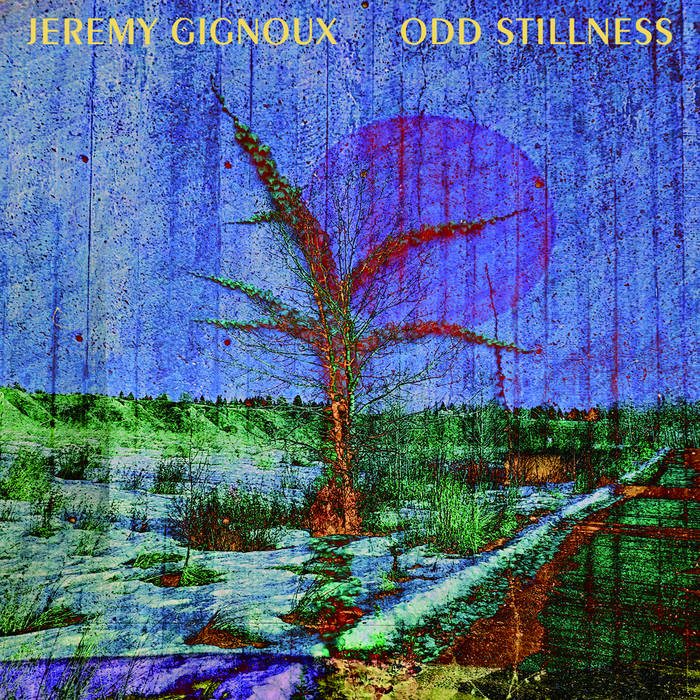
What follows is our conversation, lightly edited for clarity. The discussion touched on various topics, including the physical demands of playing sustained notes, the mental challenge of working within strict constraints, and the role of place in shaping musical identity. Gignoux’s insights offer a glimpse into the mind of a musician constantly pushing boundaries. It’s a conversation that illuminates Gignoux’s artistic process while shedding light on Calgary’s vibrant, often overlooked experimental music scene.
About Place
Lawrence Peryer: I don’t know much about Calgary or its music scene. Tell me about its musical environment.
Jeremy Gignoux: The music scene has visibly grown since I’ve been here for ten years. Of course, there’s always been a music scene, but it’s become more diverse and interesting every year. Exciting new projects and new things are going on.
But it’s still not the same caliber as Montreal or Toronto. It’s a small scene; everyone knows each other. At the same time, I remember talking to someone who was feeling this way about Montreal compared to New York. So I guess you can always compare yourself to bigger cities. But it’s an exciting place to be, especially these days.
Lawrence: What’s your connection to the place?
Jeremy: I have lived here for ten years. I came here almost randomly as a mathematics exchange student. But it’s where I met my wife and some of my first music friends and started to build a community.
Lawrence: What’s happening in terms of the dialogue between the musicians in Calgary and the musicians in Montreal in your project Calgaréal? Is it about exchanging musical traditions? Is it about place, or is it simply that you had friends on the other side of the country and decided to work together?
Jeremy: It’s a little bit of both. I lived in Montreal and felt sad leaving it behind. Calgaréal initially started as, “How can I play with these wonderful musicians again?” But I also want to make this link between those two different cities.
Montreal is often seen as this almost European city, very progressive, which is true. Calgary has this caricature of a conservative oil city with no culture, which is an unfair caricature. I think there are way more connections that can be made between the two cities, and that’s kept me going in creating Calgaréal—to show off Calgary to other people who might not have come there.
The four musicians from Montreal in the project, I think, had a lot of misconceptions about Calgary. They got a good impression of the city after visiting.
Lawrence: The closest analog I could think of to an American city would be Houston: also driven by natural resource-related businesses, experiencing dramatic growth in recent decades, but also seems to be able to support more culture than people realize. If you ask someone what they know about Calgary or Houston, they’d say country music, which might be all they understand. But if you peel away some layers, there’s more in both places.
Jeremy: Yes. I’ve never been to Houston, but it does sound similar to Calgary. When I was deciding where to do my [student] exchange and looking around North American cities, an American cousin of mine filled me in on the culture and politics of different cities. She said, “No matter where you go if it’s a big enough city, you’ll find people to connect with.” I think that’s very true of Calgary, where it’s maybe a little rough at first—there are a lot of cars, and it seems like there are not very many interesting things going on—but once you meet the people, then you’ll find the places, the communities. Maybe the artist community is fairly small, but it’s very tight and happening.
Lawrence: What I find interesting about modern-day growing cities is that all those people come from somewhere. It’s like the American Southwest, where states like Arizona, New Mexico, or Nevada draw people from the coasts when they grow. So, by definition, you’re getting people from other metropolitan areas who arrive for various reasons—some to get away, some to start over, some because of the economics of being able to get in inexpensively. But it always leads to interesting and diverse combinations you don’t necessarily expect to find.
Jeremy: I think it’s very true of Calgary. There are people from other places in Canada and around the world. It’s an incredibly diverse city. There are huge communities in Asia, Africa, and Latin America, which may be even more visible than in Montreal. Because the “born and raised in Calgary” population is not as established, there’s more room for people from other places. People born in Calgary are only a few generations old. So, many people in Calgary don’t come from Calgary, but they mix in very well with those born and raised. There’s no barrier or anything.
It’s easier for me because I’m white, but I felt very at home almost right away. When I came back, people would say, “Welcome back home,” which is incredible because it happened so fast.
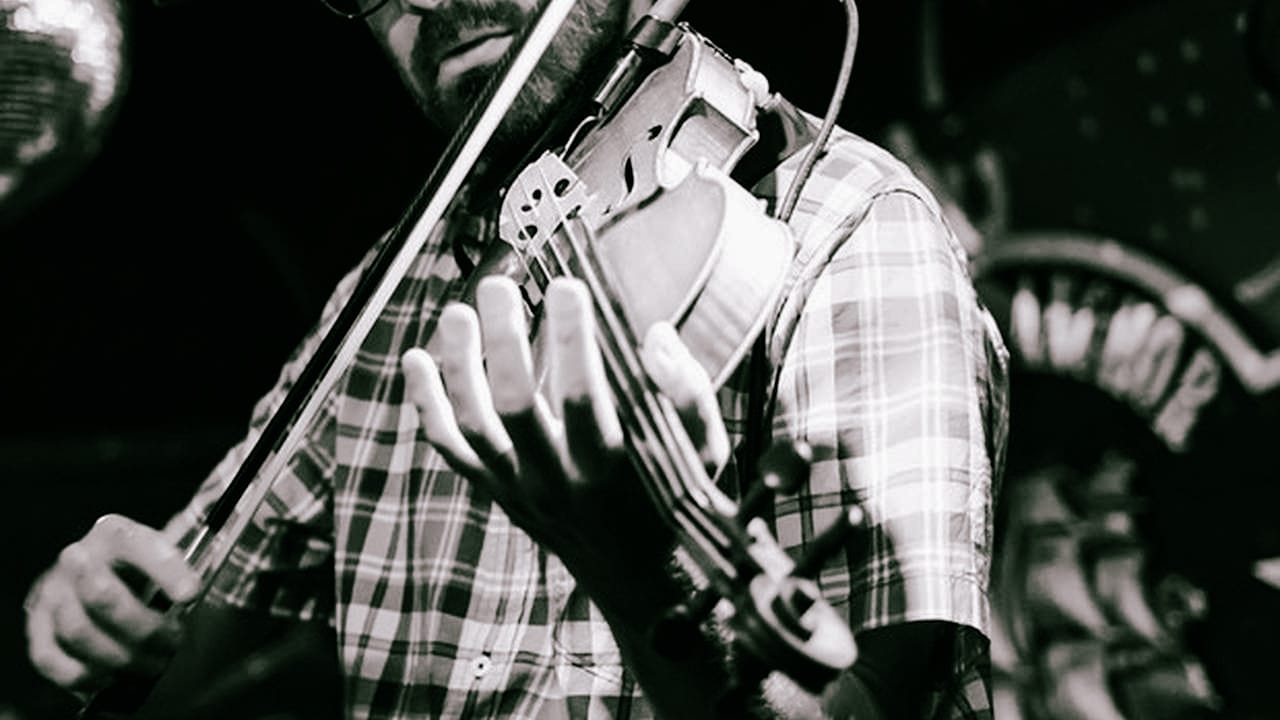
The Genesis of Odd Stillness
Lawrence: Tell me about the framework behind Odd Stillness. There’s a concept, but you don’t need to know any of that to enjoy the album. It’s got a very modern chamber music feel to it.
Jeremy: I got injured about two and a half years ago. My ulnar nerve was damaged. I couldn’t move my middle finger in my left hand, which, as a violinist, made me unable to play. I could not move the other fingers that easily, either. Fortunately, I got completely over that, but it forced me to look at my artistic practice and question if I can’t play the violin, what else can I do?
Around the same time, I collaborated with a dancer who wanted an ambient track for part of a dance piece. I had never really listened to much ambient music, but I started to see what I could do, given my condition, and to do something I’d never done. That’s how I came up with the method of stillness, of just playing one note at a time. It was easy for me to play, but I also liked it.
Lawrence: Was your hand injury a repetitive motion injury from being a musician? What caused it?
Jeremy: What caused it was changing my car battery. It was a little tricky to get out, and I think I used only my middle finger to pull it out. The next day, I realized my middle finger wouldn’t move. It impacted my musicianship, but it was not a music-related injury. It was a daily event, and I’m not changing car batteries now. My wife has to do it. [laughter]
It was scary for a little while, not only for music but also for daily things. I could not use my left hand to do almost anything. I would get pain pretty quickly. The nerve is fine now, but I still need to rebuild my muscles.
Lawrence: It’s very unnerving and scary when parts of the body you take for granted fail and stand out as not functioning properly.
Jeremy: It is. I’m now much more aware of my hands and body and know how to care for them.
Adversity into Opportunity
Jeremy: I wanted to move away from having any beats. Odd Stillness works because you only play one note every time you record without following a beat. There are instructions to follow and changes in the timbre, dynamic, and frequency. Even if there’s no beat, there can still be a lot of notes per second or less, a lot of space between long notes, short notes, and accents. Every note follows a pattern, creating an evolving texture.
It was a fun album to make, seeing each instrumentalist take these odd rules and make them their own. They didn’t respond to it the same way, which was fascinating to see when we recorded it.
Lawrence: Did each musician receive the same rules, or does each track have different rules?
Jeremy: Each track has different rules with a different set of notes and other textures. There are two instruments at most, like trumpet and trombone. Keith Rodger, who plays double bass on the second track, was good at taking time between notes. Sometimes, he would take a full minute between playing a note, leaving time to hear it, whereas others, me included, had a harder time leaving space between notes.
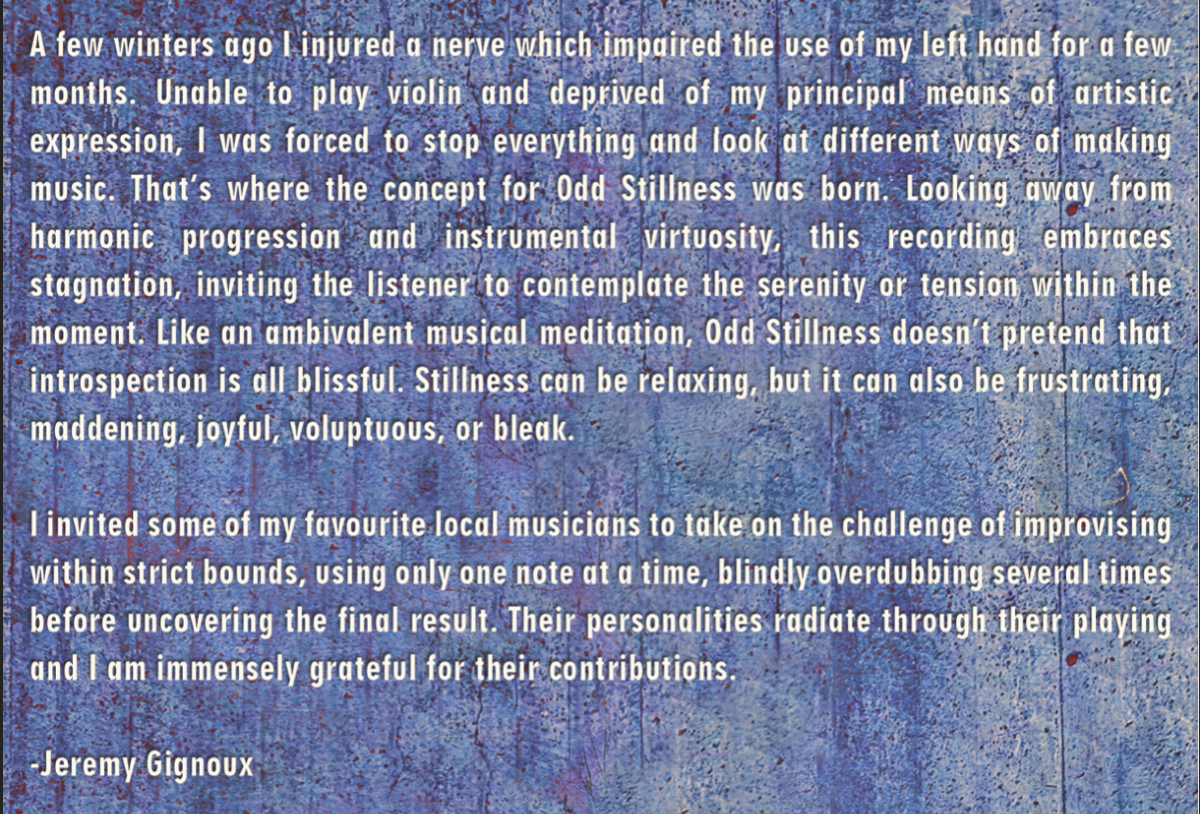
Lawrence: In the notes about the recordings, you wrote that you reserved the right to take some liberties with the rules as you were doing the production work. Not to remove the mystery, but are you on all the tracks?
Jeremy: My sound is only on one track. All the other tracks are one instrument or two with very minimal production. We sometimes removed a note or two. In the case of the flute, even if it’s a bass flute, there are two more textural elements, and we played it twice slower to make it sound even lower. That’s pretty much it.
Besides that, we tracked one note at a time, following the instructions. In the end, we finally pressed unmute and heard what the piece sounded like.
Lawrence: Am I correct in understanding that everyone recorded in the same studio?
Jeremy: Yes, one at a time.
Lawrence: I think it adds a lot to the sonic consistency of the record. You can hear the ambiance of the room. The air is the common element between all the tracks, and, for a listener, that forms a bond between the tracks, making it a consistent experience.
Jeremy: I would credit Patrick Pellardy, who tracked, mixed, and co-produced the record. So effectively, yes, it’s all in the same room. It’s good to know that the room creates this unity.
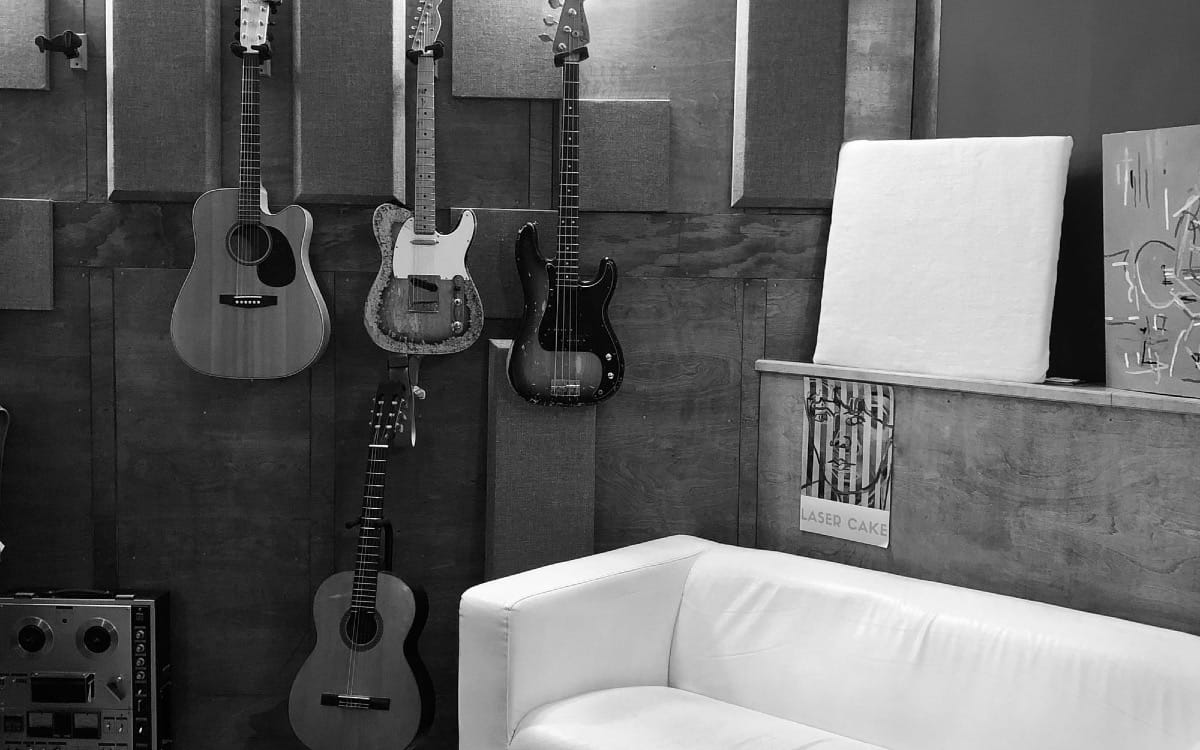
Lawrence: What about presenting the music live?
Jeremy: That is an issue because, in its essence, the album documents a recording process. However, when we released the album, I threw a listening party. I had everyone lie down on yoga mats, and we pressed play, and people experienced the music in their own ways. In the end, I was surprised by most of the musicians coming out and playing the same style—each one had a note, and we had some instructions to follow, which was fun.
The thing that cannot be replicated is the idea that the same person overdubs many times. Pulling it off would take immense time and a group of people with the same instrument. But there’s also something about the fact that they could not hear what they had done before they recorded. They’re focused on the moment, on that specific note. It would be hard to replicate unless we have earplugs and much effort. Maybe I’ll think about how to do it sometime, but I’m happy with leaving it as a recording project for now.
Lawrence: Does that mean if I am multitracking one of these pieces, I’m not doing my overdub—it’s not necessarily an overdub, it’s that I’m recording separate tracks, and I’m not hearing anything, and the tracks are being mixed later?
Jeremy: Yes. It is an overdub in that wherever the track happens to be, we will not change it. We leave that to chance. But the musicians didn’t have headphones or hear anything played before. Neither did we in the console room—all of the tracks were muted. We only heard one track at a time, and only at the end would we listen to everything.
I thought it would work, but I didn’t know the result. There was always, “Okay, let’s listen to it, see what happens.” The expression on the player was always interesting because even if there’s some textural and improvisational aspect, it’s pretty boring—one note. So, suddenly, seeing the soundscape come out of it was always fun.
Lawrence: Are the instructions a score?
Jeremy: Yes. It’s just made on an Excel sheet.
Lawrence: That’s fascinating. So, in the score, when the musician is meant to be recording what is essentially an overdub, did the musician start at that point in the score, and then would you time-shift it in the software? Or did you sit there in silence until the start point, then say, “Okay, start playing”?
Jeremy: The first attempt, we let Mark Dejong on bass clarinet sit through about two minutes of silence to see what he did. Then we figured out that maybe that was not useful.
In each song, at least three to five notes are in the main track and will happen throughout the whole piece. These tracks would be recorded from zero to five or six minutes, however long that was.
But after that, more textural events would happen. They would be shorter, maybe 30 seconds to two minutes in the middle of the song. For these, we would go straight to that point. Otherwise, for the main track, we would start, and I would say, “Okay, you can start going,” which meant they were free to start playing a note or wait a little bit before playing their first note.
Whenever there was a change in the score, whether “start playing louder” or “start putting more space between notes,” I would just point and add a predetermined number from one to five and then start again with my hand. So the musicians knew that was the next section. They were like, “Okay, now I’m in section two, so I changed something. And then, in section three, something else changes.”
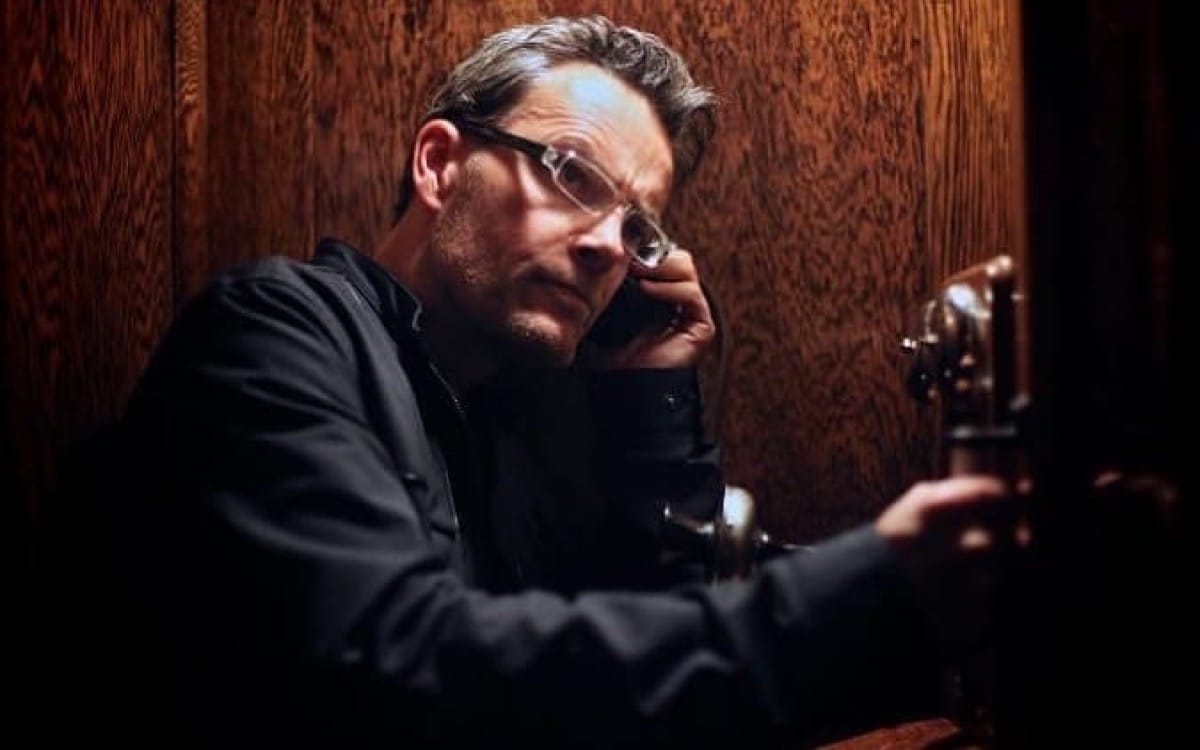
Lawrence: If you took one of those scores and had the same musician do it again or gave it to a different musician, you’d get a completely different outcome in each of those scenarios?
Jeremy: I don’t know about “completely,” but it’s different. There’s something about its random nature. My favorite moment is on the first track, near the end. It gets pretty busy and then gets quieter; there’s sudden silence, and three notes are happening almost simultaneously. That just happened randomly, and that’s a pleasing moment. It was a gift from the randomness of things. If we were to record it again, that event wouldn’t happen. Another event might happen, and the general texture and arrangement would probably still be there. It’s just that some more specific events would be different.
The musicians were free to do whatever they wanted outside of the parameters. If we didn’t say anything about timbre, they’d just play any timbre they wanted, which was wonderful. A different instrumentalist would push the boundaries of the timbre in other ways, impacting the track a lot.
Musical Diversity and Authenticity
Lawrence: What common strand exists through all the different types of music that you create? It’s a pretty diverse body of work.
Jeremy: Yes, I like that it’s diverse, and that’s important to me. But the commonalities are instrumental music in general. Even though I appreciate electronic music, it’s not my thing. I’m much more attracted to doing things with real instruments.
I’m a composer, so I like structure, but I’m also an improviser. I try to find ways to make them coexist and find a place where I can have freedom but within a structure. I always try to find things that are in between.
I also have another dichotomy between loving traditional music from around the world—sounds that have been going on for generations—and loving dissonance, new music, microtonality, and weird agglomerations of sounds. So I guess I always live in those spectrums between freedom and structure, and tradition and new music, somehow finding ways for things to connect.
Lawrence: What draws you to a sound? What’s the thing that brings you in?
Jeremy: I know when I hear it. I’m tempted to say that there’s something authentic, either in the way it’s played or the way it’s conceived—something very human and personal to the player or the composer. That’s why it ties in with traditional music; it’s often music that’s very strong at the core of the people who are playing it.
But new music can be very touching, too. That’s why I like instrumental music; I can hear the human behind it. So, I think I would say this authenticity, this individuality, is what I want.
Approaching The Uncanny Valley
Lawrence: One of the things that stood out for me on Odd Stillness was the piece that used the human voice. I often find ‘vocal new music,’ for lack of a better phrase, disturbing. The manipulation of the human voice is usually uncanny for me, and I have a hard time with it.
I did not experience that in this piece. It almost went to the edge of the stutter-stop, splitting syllable-type sound. That’s often where it gets haunting for me. But I can’t identify what it was about that piece; I found the human voice engaging and not off-putting.
Jeremy: When I first met with Rebecca Bruton, the vocalist on the piece, I asked her, “What can you do with your voice? What’s your range?” I was very surprised that she had an incredible range.
Of course, at the extremes of the range, it sounds different. She has to make her voice reach those very highs or lows, and then it doesn’t sound like her mid-range voice, but I thought that was fascinating. So I thought, “Okay, I’ll use the extremes.”
We workshopped a bunch of sounds. She just had so many things she could do with her voice. I’d like to point out that she is also a composer. So, the piece was made specifically for her voice, given what she could do, and especially the weirder-sounding things, which was helpful for the overall texture.
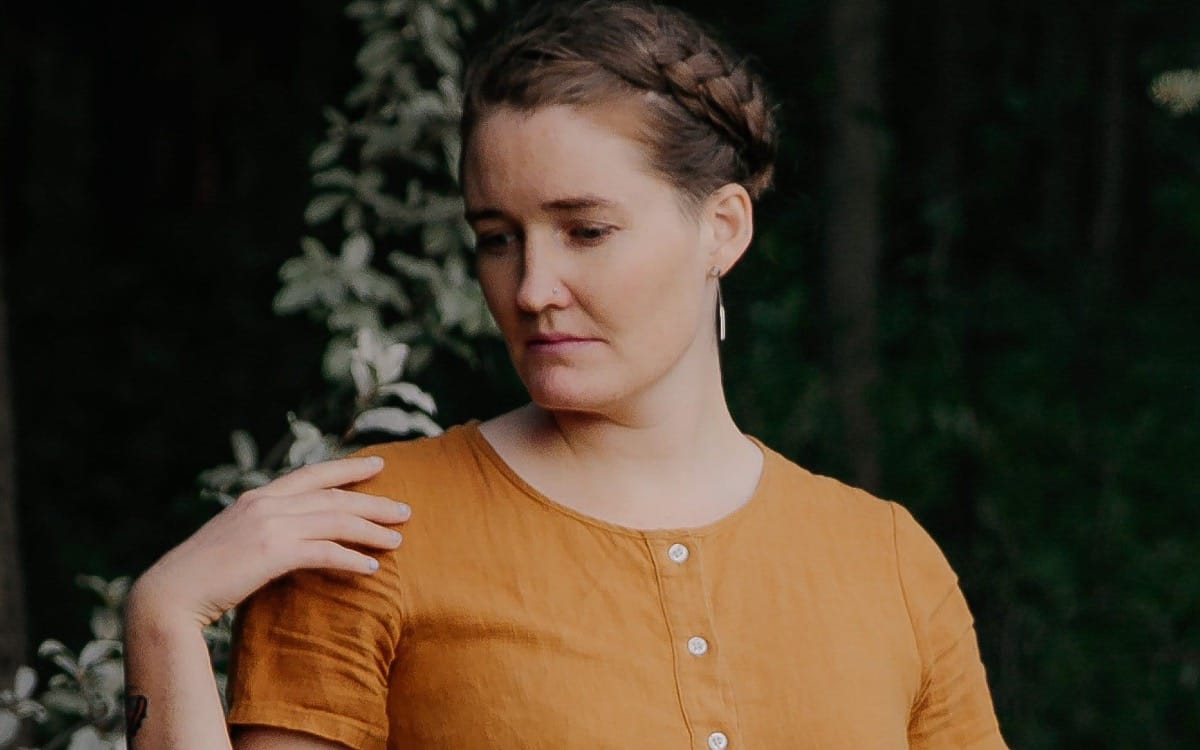
Lawrence: Do you have previous experience with instruction-based scores, either as a composer or a performer? Have you ever been given a set of instructions instead of traditional notation?
Jeremy: Yes, as an improviser, definitely a lot, either in school or improvising class. I did something similar in concept with Sarah Davachi.
She hired, I think, three or four string players to accompany her on the organ in a church in Calgary. There was this long instruction-based score; I think it was an hour. We had one instruction for 10 minutes and another for 20. We each had a few notes we would play, and then it was an uninterrupted sound—just hold a note for a minute or ten.
That was one of the most difficult gigs I’ve ever had, just because trying to play a note and play it well for so long, switching the bow and maintaining a position and not moving—you play that note for a long time.
Lawrence: I don’t think listeners appreciate the physical demands of doing less on an instrument. Holding a note can be very challenging for the body.
Jeremy: Yes. And not only on the body but on the mind as well. Having specific instructions can be hard when you’re used to improvising in different styles. You have to focus differently.
On a different gig a few weeks ago, we were instructed to play on only one string at a time. So it was me and a bass player, and we had to pick a string and stay on it. After one minute, I found myself playing a different string. I lost the game.
It’s all improvised, so there is freedom within very specific boundaries. You have to find the places where you have the freedom without going over. Sometimes, you’re like, “Oops, I guess I let myself go a little too far,” which sometimes can be fun. Maybe breaking the rule is a good thing.
Playing one note can also be hard to listen to because you hear your breath and other sounds you make. We tried in this specific recording to capture every little sound, like the sound of the tongue when swallowing, the sound of the clicks on the trumpet, or the valve. So, it’s hard on the body, it’s hard on the mind, and it’s challenging on the ear because you hear things you don’t usually hear.
Lawrence: Would you do a project like this again?
Jeremy: Yes, I’m waiting for some grants to come through, but hopefully, I’ll have more to show. I want to explore having different instruments on each track this time, and I want to go further in microtonality. Only two tracks on that album—the voice one and the violin track—have some microtonal elements. I want to do more of this, trying to find weird but gentle ways in between the notes and focus on that for an entire album.
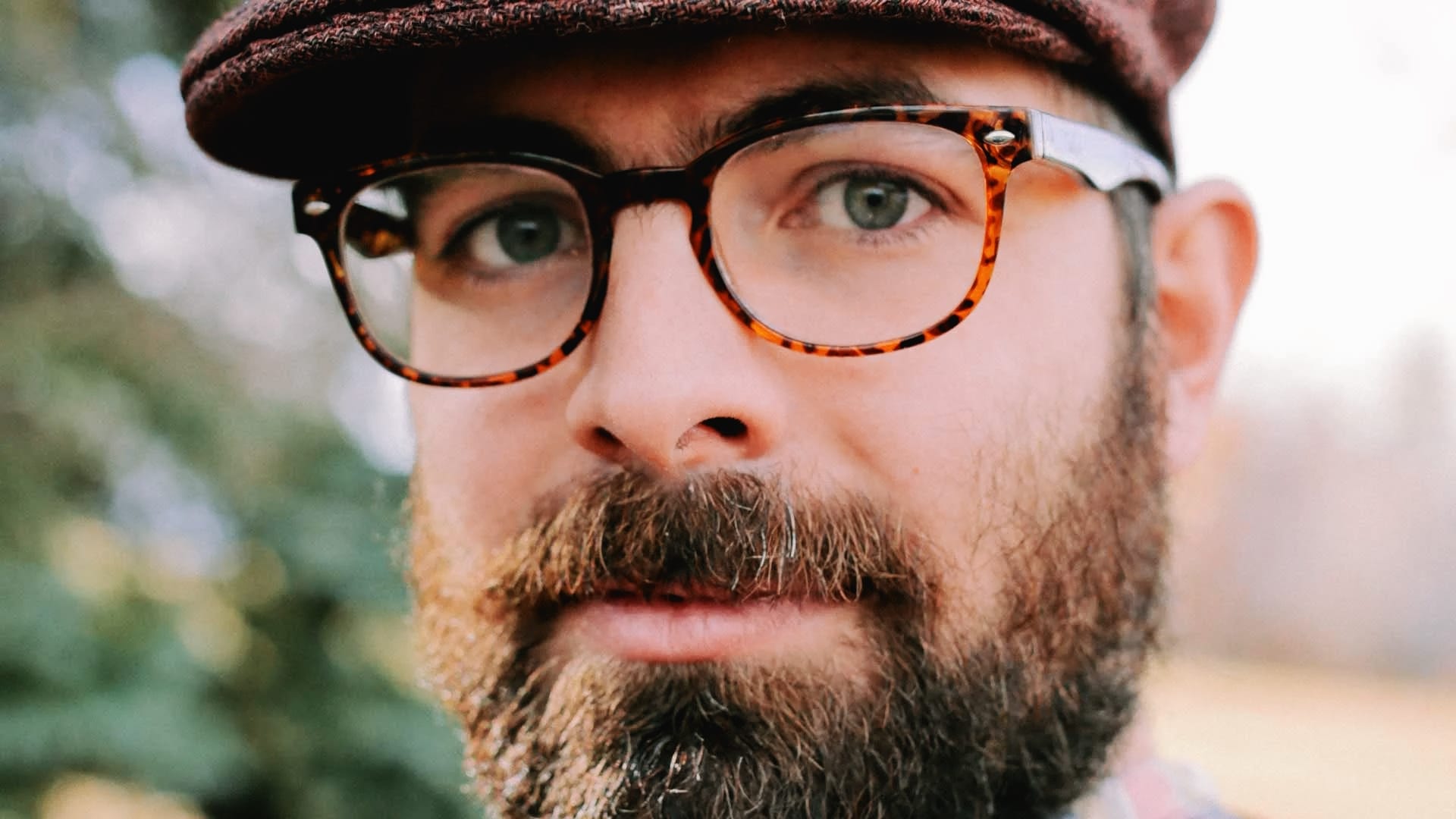
Jeremy Gignoux self-released Odd Stillness on May 10, 2024, with support from Alberta Foundation for the Arts. Calgaréal's first release, Vanishing Points, is out on October 25, 2024.


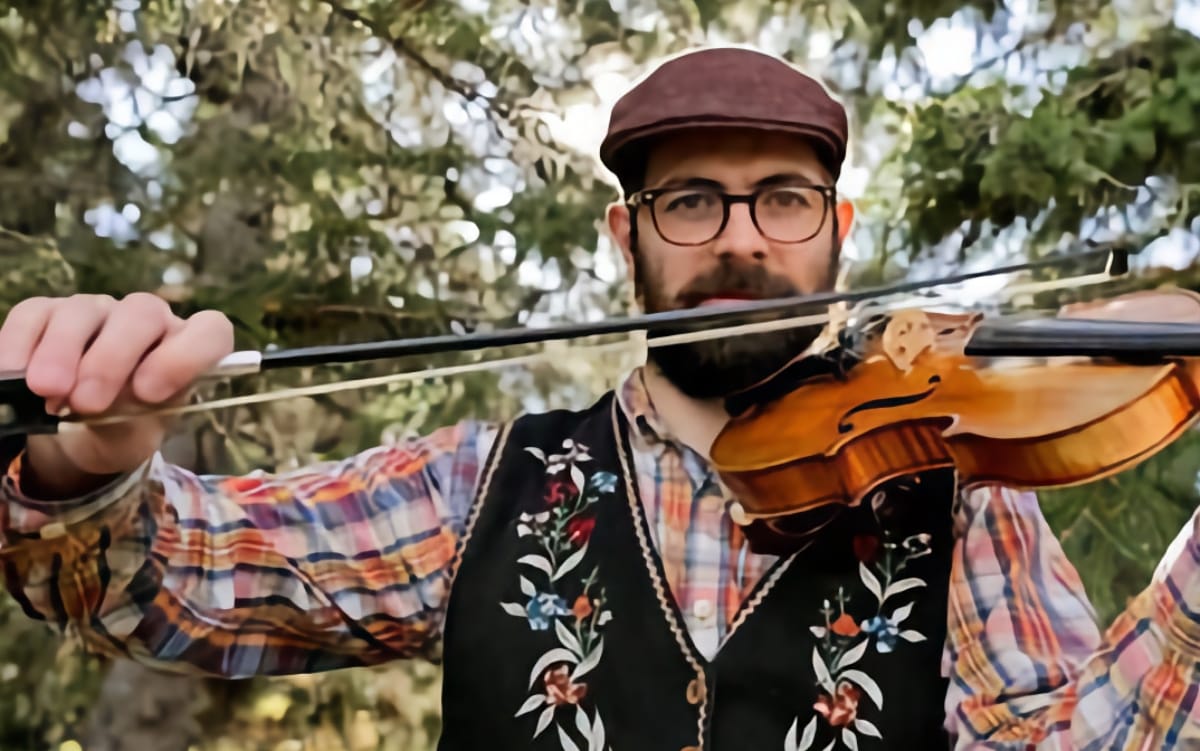




Comments